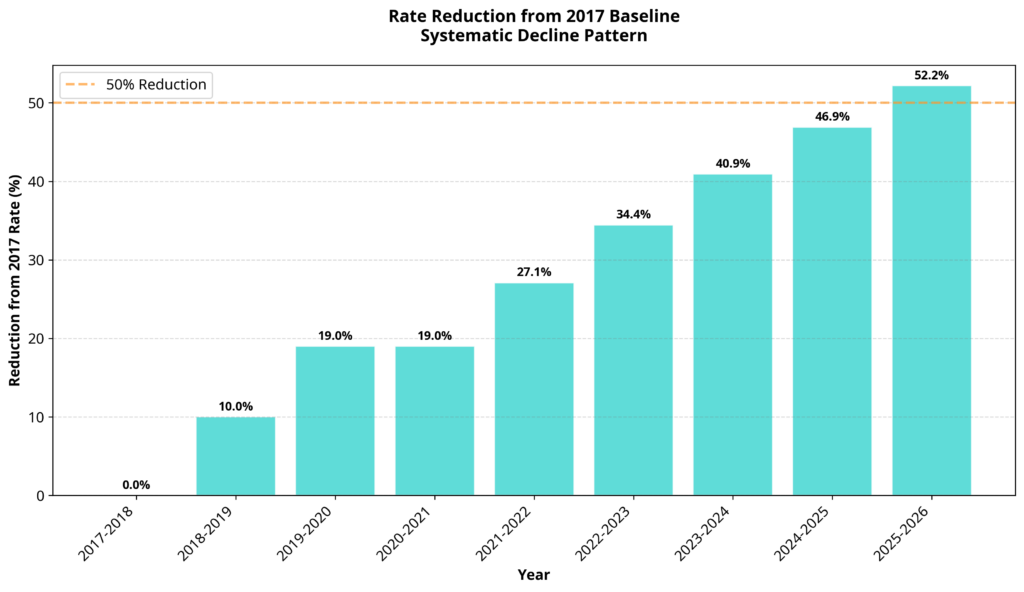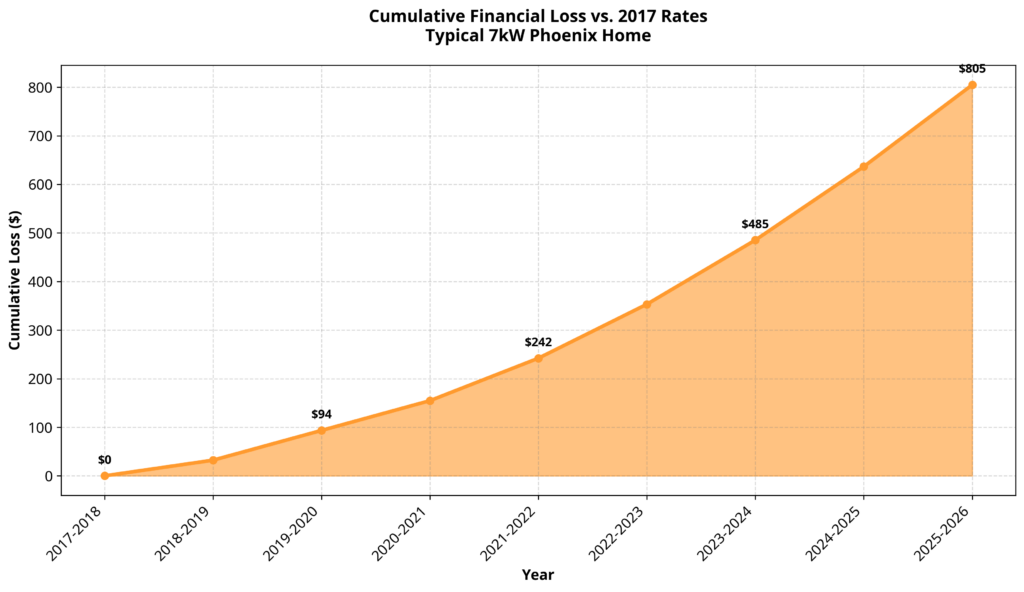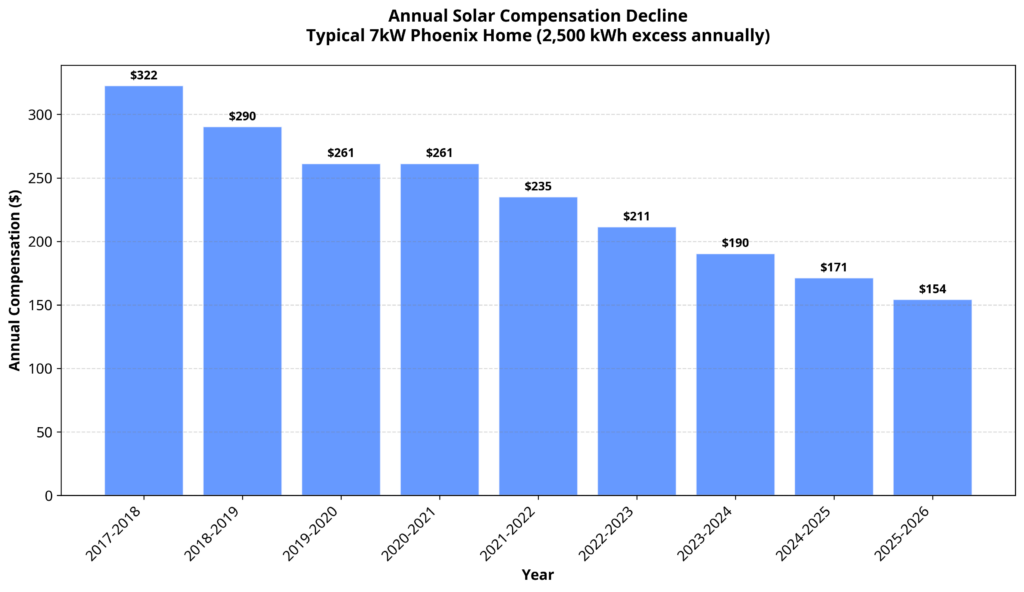APS Solar Buyback Rates Arizona: Time-Sensitive Changes Every Homeowner Must Know
APS Solar Buyback Rates Arizona: Time-Sensitive Changes Every Homeowner Must Know
Arizona homeowners face a critical deadline that could impact their solar savings for the next decade. Arizona Public Service (APS) will cut solar buyback rates by another 10% on September 1, 2025—continuing a trend that has nearly halved rates since 2017. Currently at 6.85 cents per kilowatt-hour (kWh), homeowners who act now can lock in this rate for 10 years, while those who wait will see rates drop to about 6.17 cents per kWh.This reduction isn’t just about utility bills—it’s a shift in how Arizona homeowners can benefit from solar energy long-term. Understanding these changes and exploring your options can help you make the best choice for your solar investment.
Understanding Arizona’s Solar Net Billing Landscape and Its Evolution
Arizona’s solar compensation system has undergone significant changes since the early days of renewable energy. Initially, traditional net metering offered full retail credit for excess solar energy sent to the grid. However, Arizona moved to net billing in 2017, altering how solar customers are compensated. Under the current net billing system, known as the Resource Comparison Proxy (RCP), solar customers earn credits for excess energy at rates much lower than retail electricity prices. APS values excess solar energy at approximately 60% of the cost of electricity, which impacts payback periods and long-term savings. The system uses instantaneous netting, measuring solar production and consumption in short intervals, usually hourly. Excess energy produced during peak solar hours earns lower export rates instead of offsetting higher evening electricity costs dollar-for-dollar. This has made energy storage more appealing for maximizing solar returns.
The Eight-Year Pattern: APS Rate Reduction Timeline and Financial Impact
Since 2017, APS has reduced solar buyback rates by 10% annually, except during the 2020 pandemic. This consistent reduction has created predictable but concerning trends for Arizona solar customers:
Historical APS Solar Buyback Rates:
- 2017-2018: 12.9 cents/kWh
- 2018-2019: 11.61 cents/kWh (-10%)
- 2019-2020: 10.45 cents/kWh (-10%)
- 2020-2021: 10.45 cents/kWh (no reduction due to pandemic)
- 2021-2022: 9.405 cents/kWh (-10%)
- 2022-2023: 8.456 cents/kWh (-10%)
- 2023-2024: 7.619 cents/kWh (-10%)
- 2024-2025: 6.85 cents/kWh (-10%)
- 2025-2026: 6.17 cents/kWh (projected -10%)
Solar buyback rates have dropped over 50% since the program began, a 52.2% reduction from the 2017 baseline. For a typical Phoenix home with a 7kW solar system, this decline means hundreds of dollars less in annual compensation. While the 10-year rate lock provision offers some protection for current customers, it highlights the importance of timing for new installations.

APS solar buyback rates have declined consistently since 2017, with the rate dropping from 12.9¢/kWh to a projected 6.17¢/kWh by 2026—a 52.2% total reduction.
How the September 2025 Rate Cut Directly Affects Arizona Homeowners
The upcoming rate reduction will affect solar customers differently based on their installation date and system design. For homeowners considering solar, this change highlights the urgency of acting now.
Lower compensation rates are creating a two-tiered market where installation timing greatly impacts long-term returns. Payback period analysis shows rate cuts have extended the time needed for systems to pay for themselves. Systems installed in 2017 typically paid off in 7-8 years, while those installed after September 2025 may take 9-10 years.
A 7kW Solar System Example in Phoenix
Consider a typical Phoenix household with a 7kW solar system exporting 2,500 kWh annually to the grid. At the current rate of 6.85 cents per kWh, this household earns $171.25 in annual credits. After September 1, credits drop to $154.25—a $17 annual difference. Over the 10-year rate lock period, this amounts to $170+ in reduced compensation, excluding inflation or further rate cuts.
The impact is more significant given Arizona’s abundant solar resources and the widening gap between retail electricity rates and buyback credits. Arizona ranks fifth in the U.S. for total solar generation, with many residential systems producing substantial excess energy during peak hours. APS currently values excess solar at just 60% of what homeowners pay for electricity, and this gap grows with each rate cut.
Going Solar in 2025 Saves You Money in the Long Run
Existing solar customers with higher secured rates benefit from the 10-year rate lock. For instance, a homeowner who installed solar in 2018 still earns 11.61 cents per kWh through 2028, nearly double the rate new customers will receive post-September 2025. This disparity underscores the financial advantage of acting before rate cuts and highlights the rate lock as critical protection against future reductions.
Delaying solar installation has significant opportunity costs, including lost energy savings and exposure to future rate reductions. Each month of delay means missed solar production, while further rate cuts create uncertainty about long-term savings. Even a few cents per kWh can add up significantly over a decade, with nearly 87,000 hours in that timeframe.
The financial impact extends beyond households, influencing Arizona’s broader solar adoption. As buyback rates decline, strategies like battery storage and system right-sizing become crucial for maximizing returns. This shift in solar economics makes timing critical for homeowners aiming to optimize their energy investments.
Strategic Actions to Maximize Solar Investment Before the Deadline
Arizona homeowners must meet specific requirements to secure current buyback rates before the September 1 deadline. Working with experienced solar contractors can help lock in rates and avoid the costly mistake of missing this deadline.
Critical Requirements for Rate Lock:
- Submit the interconnection application to APS before September 1, 2025
- Complete system installation and receive Permission to Operate (PTO) within 180 days of application submission
- Use certified solar equipment and licensed installers meeting APS specifications
- Select the appropriate rate plan during the application process
The interconnection process typically takes 4-6 weeks from application to approval, depending on system complexity and APS’s review queue. Installation can take 1-3 months, especially during peak demand. Homeowners should begin their solar evaluation now, as most contractors recommend signing contracts by August 21 to meet the September 1 deadline.
What if I missed the September 1 2025, APS Buyback Deadline
If you missed the September 1, 2025, APS buyback deadline, you still have options to benefit from solar energy. While you may no longer qualify for the current rate plan, future buyback programs or alternative rate plans may still offer financial incentives. Additionally, installing solar panels can help reduce your energy consumption from the grid and protect you from rising electricity costs.
Reach out to your solar provider or APS to discuss available options, and consider monitoring program updates to take advantage of new opportunities as they arise. Planning can ensure you maximize both the environmental and economic benefits of transitioning to solar power.
Keep in Mind that the ITC Credit Goes Away in 2026
Federal and state solar incentives remain strong through 2025, with the 30% federal Investment Tax Credit (ITC) significantly reducing upfront costs. Arizona also offers a $1,000 state tax credit and a sales tax exemption, but proposed federal legislation may eliminate the ITC after December 31, 2025—adding urgency beyond the buyback rate deadline.
APS processes interconnection applications in the order they’re received, so submitting early ensures faster review. As the September 1 deadline nears, application volumes typically rise, potentially delaying approvals, making early action critical.
Arizona Homeowners Should Consider Their Future Expansion Needs
Homeowners should also consider future expansion needs. APS allows customers to increase system capacity by up to 10% or 1kW (whichever is greater) while keeping their locked-in buyback rate. Planning for increased electricity use can preserve favorable terms for future upgrades.
Battery Storage: The Smart Alternative to Declining Buyback Rates
As APS buyback rates keep declining, solar battery storage is becoming an attractive option for Arizona homeowners to maximize their solar investment while reducing reliance on utility compensation. Battery storage costs in Arizona average $999 per kWh of capacity, with complete systems costing $11,000-$15,000 before incentives.
The value of solar battery storage lies in shifting energy use from high-rate periods to times when solar production is high. Instead of sending excess solar energy to the grid at low buyback rates, homeowners can store it and use it during peak periods when electricity is more expensive. This becomes more valuable as the gap between retail and buyback rates grows.
Peak Hour Rate Avoidance:
APS time-of-use rates can exceed 25 cents per kWh during peak summer hours, while buyback rates have fallen to just 6.17 cents per kWh after September 1st. This 19-cent differential means that each kWh of solar energy stored and used during peak hours provides nearly four times more value than the same energy exported to the grid.
Maximized Self-Consumption:
Rather than selling excess solar energy at reduced rates and purchasing grid electricity at full retail rates, batteries enable homeowners to store their own production for evening and overnight use. This strategy becomes increasingly valuable as buyback rates decline and retail electricity rates increase, allowing homeowners to achieve greater energy independence.
Demand Charge Management:
For customers on APS rate plans with demand charges, batteries can reduce peak power draw during high-cost periods. APS measures demand charges based on the highest hour of usage during on-peak periods, making strategic battery discharge valuable for cost management and bill reduction.
Energy Security and Resilience:
Arizona experiences periodic grid outages due to extreme weather, equipment failures, and maintenance activities. Unlike traditional backup generators that require fuel and maintenance, battery backup systems provide silent, automatic power during outages while contributing to daily energy management. This dual functionality enhances the overall value proposition of battery investments.
Battery economics have improved significantly with federal tax credits and falling equipment costs. Solar batteries qualify for the 30% federal ITC like solar panels, reducing typical residential installation costs to $7,000-$10,500. In Arizona, 10kWh battery systems cost about $6,993 after tax credits.
As buyback rates drop and battery costs decline, battery storage becomes increasingly cost-effective compared to grid export. Break-even analysis shows battery systems can pay off in 8-12 years through peak rate savings and backup power benefits. With further declines in costs and buyback rates, payback times are expected to shorten, making storage a key part of future solar setups.
Long-Term Market Implications for Arizona’s Solar Industry
The continued drop in APS buyback rates reflects broader trends influencing solar adoption in Arizona and the Southwest. These changes impact not just homeowners but also market dynamics, policy, and renewable energy growth.
The Arizona Solar Market Stays Strong
Arizona’s solar market remains strong despite changes to net billing. The Solar Energy Industries Association reports steady growth in installations, driven by abundant sunlight, falling equipment costs, and consumer interest in energy independence. However, lower buyback rates are shifting strategies for solar adoption.
The rise of solar-plus-storage systems marks a key market shift. As buyback rates drop, battery costs fall, and electricity prices rise, self-consumption becomes more cost-effective than exporting to the grid. This transition supports utility grid modernization, easing peak demand and boosting reliability.
The Arizona Corporation Commission’s (ACC) Policies Matter
Policy discussions at the Arizona Corporation Commission continue to shape solar compensation. While current rules allow annual rate cuts through 2032, future changes could alter this path based on grid needs, renewable goals, and consumer advocacy. Solar advocacy groups are working to maintain fair compensation for distributed solar.
Federal incentives add another layer of complexity. If the ITC expires as planned, Arizona solar could face reduced federal support alongside buyback rate cuts, highlighting the importance of acting now for favorable solar economics.
Taking Action: Your Step-by-Step Guide to Securing Current APS Rates
Arizona homeowners ready to move forward with solar installation before the September deadline should follow a systematic approach to ensure successful rate lock and optimal system design. The compressed timeline requires prompt decision-making and coordinated action, but the financial benefits far outweigh the challenges of meeting the deadline.
Immediate Actions (Complete by August 1, 2025):
- Energy Assessment: Gather 12 months of APS electricity bills to establish baseline consumption patterns and identify optimal system sizing
- Property Evaluation: Assess roof condition, orientation, shading, and available space for solar panel installation
- Contractor Selection: Research and interview licensed Arizona solar contractors with proven APS interconnection experience
- System Design: Work with the chosen contractor to develop system specifications, equipment selection, and project timeline
Application Process (Complete by August 15, 2025):
- Contract Execution: Finalize solar installation contract with chosen contractor
- Permit Applications: Submit required building permits and HOA approvals (if applicable)
- APS Interconnection Application: Complete and submit the interconnection application with system specifications
- Rate Plan Selection: Choose the appropriate APS solar rate plan during the application process
Installation and Activation (Complete by February 1, 2026):
- System Installation: Complete solar panel and inverter installation per approved plans
- Inspection and Testing: Pass required building and electrical inspections
- APS Final Inspection: Schedule and pass the APS interconnection inspection
- Permission to Operate: Receive PTO approval and activate the system
Maintaining regular communication with your solar contractor about timeline progress and potential delays is key. Factors like weather, permit processing, and equipment availability can affect schedules, so starting early is crucial to meet the September deadline.
While the September 1st deadline adds time pressure, it’s important to make informed decisions based on your specific circumstances. Homeowners should carefully weigh their options, understand long-term impacts, and work with qualified professionals for expert guidance.
Solar installation involves external timelines and backlogs, so starting your APS solar project now is vital to avoid delays and secure lower utility bills sooner. Acting early helps you lock in current buyback rates and federal incentives before potential policy changes.
Financial Analysis: Current Rates vs. Post-Deadline Rates Over 20 Years
To illustrate the long-term financial impact of the September rate reduction, consider a comprehensive analysis of a typical Phoenix solar installation under both scenarios. The cumulative effect of these systematic rate reductions has created substantial financial differences for Arizona homeowners based solely on their installation timing.

The difference between locking in rates in 2017 versus 2025 represents a cumulative loss of $805 over ten years for a typical Arizona home, highlighting the importance of timing in solar investments.
System Specifications for Analysis:
- 7kW solar panel system
- Annual production: 11,500 kWh
- Annual household consumption: 8,500 kWh
- Annual excess export: 3,000 kWh
- System cost: $19,600 before incentives ($13,720 after 30% federal ITC)
Scenario 1: Installation Before September 1 (6.85 cents/kWh rate lock)
- Annual export credits: $205.50
- 10-year locked credits: $2,055
- Years 11-20 credits (estimated declining rates): $1,500
- Total 20-year export value: $3,555
Scenario 2: Installation After September 1 (6.17 cents/kWh rate lock)
- Annual export credits: $185.10
- 10-year locked credits: $1,851
- Years 11-20 credits (estimated declining rates): $1,350
- Total 20-year export value: $3,201
Difference: $354 over 20 years, or $17.70 annually
However, this analysis reveals even more dramatic differences when comparing current rates to the original 2017 baseline. A homeowner who installed a typical 8kW solar system in 2017 and locked in the 12.9 cent buyback rate can expect total system savings of approximately $28,000 over the system’s 25-year lifespan, while the same system installed after September 2025 would generate approximately $22,400 in savings—a difference of $5,600.
The annual compensation decline for a typical 7kW Phoenix home producing 2,500 kWh of excess energy shows the stark reality of this systematic reduction:

Annual compensation has declined from $322 in 2017 to a projected $154 in 2026, representing a 52% reduction in value for identical solar production.
While the immediate rate difference may seem modest, it represents pure lost value for identical solar production. More importantly, this analysis assumes modest consumption patterns and doesn’t account for additional rate reductions beyond 2026. If APS continues 10% annual reductions through 2032 (the current regulatory authorization), the cumulative difference grows substantially, potentially reaching $500-$700 over a 20-year system life.
The analysis also doesn’t account for potential inflation or the time value of money, which would make the actual cost of delay even higher when considering present value calculations.
Making Your Decision: Is Solar Still Worth It in Arizona After Rate Cuts?
Despite declining buyback rates, solar remains a strong financial investment for most Arizona homeowners when properly designed and installed. Arizona solar installations typically achieve 6-year payback periods with $26,388 in average 20-year savings, even under current net billing policies.
Your Solar Future Starts with Today’s Decision
The September 1, 2025, APS buyback rate reduction marks a pivotal moment for Arizona’s renewable energy. Homeowners who act now can lock in decades of solar benefits under current conditions.
Arizona’s solar future remains bright, backed by abundant resources, supportive policies, and growing demand for energy independence. Even as buyback rates drop, solar still offers lower bills, environmental benefits, and increased home value.
Homeowners have a choice: secure current rates and incentives now or face higher costs later. With proper planning and experienced contractors, solar investments remain valuable despite policy changes.
Act now. Contact qualified solar contractors to start your evaluation before the September 1 deadline. Your future self will thank you.
Ready to secure your solar future before the APS rate cut? Contact licensed Arizona solar contractors immediately to begin your system evaluation and interconnection application process. Time is limited, but the potential for long-term savings and energy independence makes this decision one of the most important investments you can make for your home and family.











